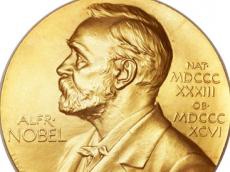|
|
TODAY.AZ / Weird / Interesting
2013 physics Nobel prize goes to British Higgs and Belgian Englert
08 October 2013 [16:00] - TODAY.AZ
 Britain's Peter Higgs and Francois Englert of Belgium won the Nobel Prize for physics on Tuesday for predicting the existence of the Higgs boson particle that explains how elementary matter attained the mass to form stars and planets, Reuters reported.
Britain's Peter Higgs and Francois Englert of Belgium won the Nobel Prize for physics on Tuesday for predicting the existence of the Higgs boson particle that explains how elementary matter attained the mass to form stars and planets, Reuters reported.Half a century after their original work, the new building block of nature was finally detected in 2012 at the CERN research centre's giant, underground particle-smasher near Geneva. The discovery was hailed as one of the most important in physics.
The two scientists had been favorites to share the 8 million Swedish crown ($1.25 million) prize after their theoretical work was vindicated by the CERN experiments.
To find the elusive particle, scientists at the Large Hadron Collider (LHC) had to pore over data from the wreckage of trillions of sub-atomic proton collisions.
"The awarded theory is a central part of the Standard Model of particle physics that describes how the world is constructed," the Royal Swedish Academy of Sciences said in a statement.
"According to the Standard Model, everything, from flowers and people to stars and planets, consists of just a few building blocks: matter particles."
The Higgs boson is the last piece of the Standard Model of physics that describes the fundamental make-up of the universe. Some commentators - though not scientists - have called it the "God particle", for its role in turning the Big Bang into an ordered cosmos.
The will of Swedish dynamite millionaire Alfred Nobel limits the award to a maximum of three people. Yet six scientists published relevant papers in 1964 and thousands more have worked to detect the Higgs at the LHC.
Englert, 80, and his colleague Robert Brout - who died in 2011 - were first to publish, but 84-year-old Higgs followed just a couple of weeks later and was the first person to explicitly predict the existence of a new particle.
Similar proposals from American researchers Carl Hagen and Gerald Guralnik and Britain's Tom Kibble appeared shortly afterwards.
Their combined work shows how elementary particles inside atoms gain mass by interacting with an invisible field pervading all of space - and the more they interact, the heavier they become. The particle associated with the field is the Higgs boson.
/Trend/
URL: http://www.today.az/news/interesting/127052.html
 Print version
Print version
Views: 1378
Connect with us. Get latest news and updates.
See Also
- 06 December 2024 [22:20]
Are scented candles harmful to health? - 23 November 2024 [14:11]
Magnitude 4.5 earthquake hits Azerbaijan's Lachin - 20 November 2024 [23:30]
Launch vehicle with prototype of Starship made its sixth test flight - 27 October 2024 [09:00]
Fuel prices expected to rise in Sweden - 24 October 2024 [19:14]
Turkiye strikes terror targets in Iraq and Syria - 23 October 2024 [23:46]
Kazakhstan supplied almost entire volume of oil planned for 2024 to Germany in 9 months - 23 October 2024 [22:17]
Taiwan reported passage of Chinese Navy aircraft carrier near island - 23 October 2024 [21:50]
Russia remains largest oil supplier to India - 16 October 2024 [17:54]
Gamesummit co-founder shares insights on future of gaming industry in Azerbaijan [EXCLUSIVE] - 12 October 2024 [18:27]
TikTok cuts jobs, turns to AI for content moderation
Most Popular
 More Armenians fly: the crisis of power in Canada
More Armenians fly: the crisis of power in Canada
 Azerbaijan, Colombia Discuss Cooperation in Various Fields
Azerbaijan, Colombia Discuss Cooperation in Various Fields
 Azerbaijani delegation participates in internet governance forum in Riyadh
Azerbaijani delegation participates in internet governance forum in Riyadh
 Armenian militant group threatens regional stability aligning with PKK/YPG in new ground
Armenian militant group threatens regional stability aligning with PKK/YPG in new ground
 Rubik Vardanyan surprises his own lawyers
Rubik Vardanyan surprises his own lawyers
 Azerbaijan's role in COP29 highlights growing global influence, says MEDIA Director
Azerbaijan's role in COP29 highlights growing global influence, says MEDIA Director
 Lapshin shows up, again collecting alms from naive Armenians
Lapshin shows up, again collecting alms from naive Armenians
